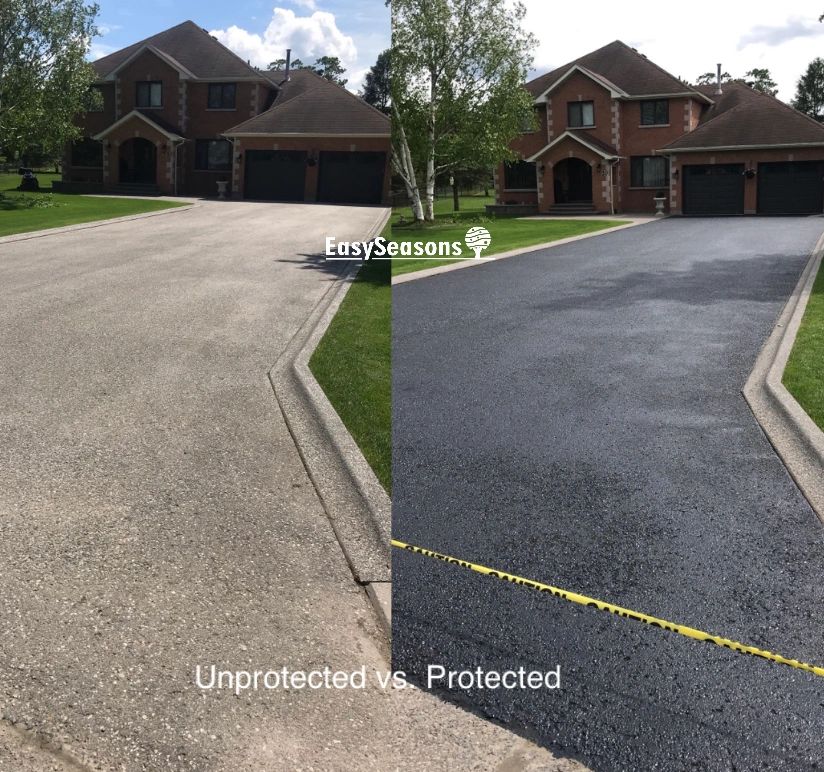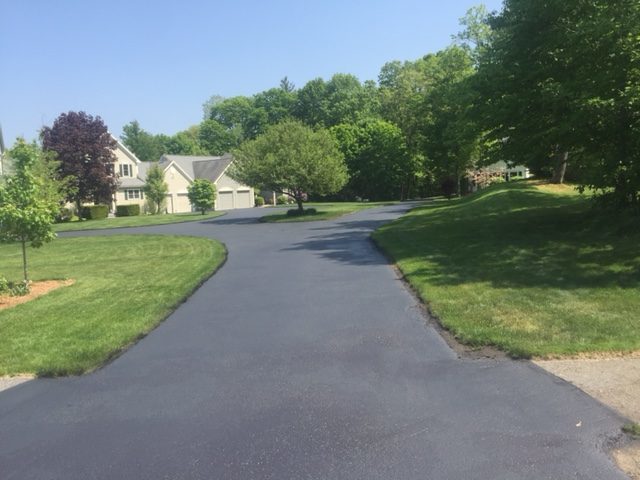Release the Prospective: Regrading and Asphalt Sealing for Industrial Areas
Release the Prospective: Regrading and Asphalt Sealing for Industrial Areas
Blog Article
Warm Mix Asphalt: A Lasting Service for Sidewalk
Warm Mix Asphalt (HMA) has arised as a leading sustainable choice for pavement remedies, supplying a myriad of ingenious modern technologies and environmental benefits. Its capability to reuse materials and lower energy consumption presents a compelling case for its fostering in roadway building and construction jobs. Moreover, the long-term performance and resilience of HMA make it a recommended choice for framework growth. As the need for green construction practices expands, checking out the subtleties of HMA's sustainability can offer beneficial insights right into the future of sidewalk remedies.
Environmental Advantages of Hot Mix Asphalt
:max_bytes(150000):strip_icc()/barricade-tape-sealed-driveway-big-56a583145f9b58b7d0dd3d87.jpg)
Furthermore, Warm Mix Asphalt helps to minimize metropolitan warmth island impacts. Its dark shade soaks up sunlight, reducing the amount of heat reflected back into the environment contrasted to lighter-colored pavements. This can reduce ambient temperature levels in urban locations, lowering the need for air conditioning and eventually minimizing power consumption.
Furthermore, Hot Mix Asphalt adds to improved stormwater monitoring. Its porous nature allows water to penetrate the sidewalk and reenergize groundwater supplies, lowering overflow and the threat of flooding. These environmental benefits make Warm Mix Asphalt a lasting choice for leading highways and roads.
Energy Effectiveness in HMA Manufacturing
Is power efficiency an essential consider the manufacturing of Warm Mix Asphalt (HMA)? Absolutely. Power plays a considerable duty in the production of HMA, influencing both price and ecological sustainability. One key element of energy performance in HMA production is the usage of warm mix asphalt (WMA) modern technologies (commercial parking lot paving). WMA enables the blending and positioning of asphalt at reduced temperature levels contrasted to traditional hot mix asphalt, leading to minimized energy consumption throughout manufacturing. This procedure not only reduces fuel use however additionally decreases greenhouse gas exhausts, making it a more eco-friendly option.
Moreover, innovations in plant technologies have led to more energy-efficient HMA manufacturing procedures. Modern plants are created with functions like recycled asphalt sidewalk (RAP) handling capacities, effective burner systems, and enhanced insulation, all contributing to power savings. By enhancing energy usage in HMA manufacturing, the market can lower its carbon footprint while maintaining top quality sidewalk materials. Energy effectiveness is, therefore, an essential factor to consider in guaranteeing the sustainability of Warm Mix Asphalt production.
Recyclability of Warm Mix Asphalt
The recyclability of Hot Mix Asphalt (HMA) is a pivotal aspect of its sustainability and long-term environmental effect. HMA is among the most recycled products in the United States, with over 100 million lots of reclaimed asphalt sidewalk (RAP) being recycled yearly in brand-new sidewalk building. Recycling HMA supplies several ecological advantages, such as reducing the requirement for virgin materials, lowering power consumption throughout manufacturing, and lowering the quantity of waste sent to landfills.
The procedure of recycling HMA includes milling the existing pavement, crushing it into smaller sized items, and mixing it with brand-new aggregate and asphalt binder to develop a recycled mix. This recycled visit this site mix can usually carry out in addition to and even far better than traditional HMA, while needing fewer additional hints resources and producing reduced greenhouse gas exhausts. By incorporating RAP into new pavement jobs, road firms can preserve natural deposits, lower prices, and reduce the ecological impact of roadway building and construction and upkeep tasks. Overall, the recyclability of HMA plays a considerable role in advertising sustainable methods within the sidewalk industry.

Long-Term Efficiency of HMA
Asphalt pavements show resilience and resilience over an extensive duration, reflecting the long-lasting efficiency of Warm Mix Asphalt (HMA) The long life of HMA can be credited to its ability to stand up to rush hour lots, rough climate condition, and the effects of aging. Researches have actually revealed that properly designed and effectively created HMA pavements can last for 20 years or even more with normal upkeep. The secret to making best use of the long-lasting efficiency of HMA hinges on making use of top notch materials, following finest practices try this out in construction, and carrying out reliable upkeep approaches. Proper water drainage, regular inspections, and prompt repair work are necessary for protecting the architectural stability of HMA sidewalks over time. Additionally, developments in HMA technology, such as making use of polymer-modified binders and warm mix asphalt, have actually additionally improved the sturdiness and long life of HMA pavements. By prioritizing top quality construction and maintenance methods, HMA remains to confirm itself as a economical and lasting remedy for lasting pavement infrastructure.

HMA: Toughness and Sustainability
Showing both toughness and sustainability, Warm Mix Asphalt (HMA) has actually come to be a keystone in the building and construction of long-lasting sidewalk frameworks - commercial parking lot paving. HMA's sturdiness comes from its capacity to withstand heavy lots, extreme climate condition, and high web traffic volumes, making it a trusted selection for highways, freeways, and airport runways. The structure of HMA, which normally includes accumulations, binder, and filler, plays an important duty in improving its long life and resistance to deterioration
In addition, HMA's sustainability depends on its recyclability and energy-efficient production process. The capability to recycle recovered asphalt sidewalk (RAP) in new HMA mixes reduces the need for virgin products and lessens the ecological impact of pavement building and construction and maintenance. Furthermore, the energy performance of producing HMA lies in its reduced blending temperatures compared to various other sidewalk products, leading to lowered energy consumption and greenhouse gas discharges.
Verdict
In final thought, warm mix asphalt (HMA) supplies a lasting service for pavement with its eco pleasant qualities. HMA's recyclability, energy effectiveness in production, and long-term sturdiness make it an environment-friendly option for roadway building.
HMA is one of the most recycled products in the United States, with over 100 million heaps of redeemed asphalt sidewalk (RAP) being recycled every year in brand-new sidewalk building and construction.The process of recycling HMA entails milling the existing pavement, squashing it into smaller sized pieces, and blending it with new accumulation and asphalt binder to create a recycled mix.Asphalt sidewalks show resilience and resilience over an extensive duration, reflecting the long-lasting efficiency of Hot Mix Asphalt (HMA) Furthermore, developments in HMA modern technology, such as the use of polymer-modified binders and warm mix asphalt, have actually even more improved the sturdiness and long life of HMA pavements. The capability to recycle recovered asphalt sidewalk (RAP) in brand-new HMA combinations minimizes the demand for virgin materials and lessens the ecological impact of sidewalk construction and upkeep.
Report this page